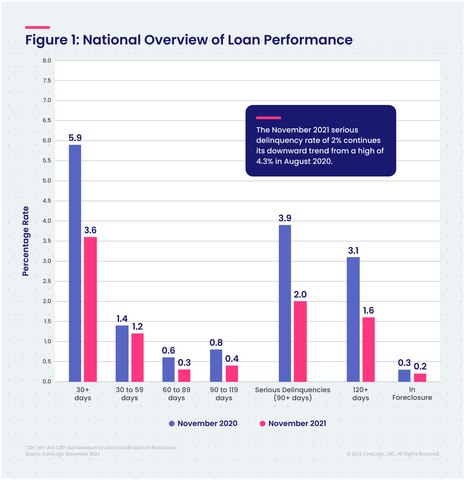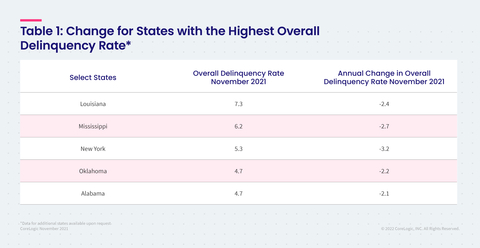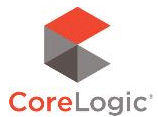Additionally, all stages of delinquency showed year-over-year declines in November 2021
Irvine, CA – February 8th, 2022 (BUSINESS WIRE)–CoreLogic, a leading global property information, analytics and data-enabled solutions provider, today released its monthly Loan Performance Insights Report for November 2021.
For the month of November, 3.6% of all mortgages in the U.S. were in some stage of delinquency (30 days or more past due, including those in foreclosure), representing a 2.3-percentage point decrease compared to November 2020, when it was 5.9%.
To gain a complete view of the mortgage market and loan performance health, CoreLogic examines all stages of delinquency. In November 2021, the U.S. delinquency and transition rates, and their year-over-year changes, were as follows:
- Early-Stage Delinquencies (30 to 59 days past due): 1.2%, down from 1.4% in November 2020.
- Adverse Delinquency (60 to 89 days past due): 0.3%, down from 0.6% in November 2020.
- Serious Delinquency (90 days or more past due, including loans in foreclosure): 2%, down from 3.9% in November 2020 and a high of 4.3% in August 2020.
- Foreclosure Inventory Rate (the share of mortgages in some stage of the foreclosure process): 0.2%, down from 0.3% in November 2020. This remains the lowest foreclosure rate recorded since 1999.
- Transition Rate (the share of mortgages that transitioned from current to 30 days past due): 0.6%, down from 0.8% in November 2020.



For the first time since the onset of the pandemic, national overall delinquency dropped below the March 2020 level of 3.6%, a sign that mortgage performance is following the nation’s income growth. At the same time, foreclosure rates remain at historic lows as borrowers have been able to lean into the equity generated by a year of record-breaking home price growth. These factors combined have helped borrowers weather the lasting economic impacts brought on by the pandemic and avoid falling behind on payments or losing their homes.
“Nonfarm employment rose 6.45 million during 2021, helping to rebuild income for families under financial stress during the pandemic,” said Dr. Frank Nothaft, chief economist at CoreLogic. “Income growth has helped to reduce past-due rates and home equity build-up has reduced the likelihood of a distressed sale for families that experience financial challenges.”
State and Metro Takeaways:
- In November 2021, all states logged year over year declines in their overall delinquency rate. The states with the largest declines were: Nevada (down 3.8 percentage points); New Jersey (down 3.6 percentage points); Hawaii (down 3.5 percentage points); Florida (down 3.4 percentage points); and New York (down 3.2 percentage points).
- All except one U.S. metropolitan area posted at least a small annual decrease in their overall delinquency rate. The one area with an annual increase in November 2021 was Houma-Thibodaux, Louisiana (up 0.4 percentage points). Houma was impacted by Hurricane Ida in the fall, but its November delinquency rate is an improvement from October as the area works to recover.
The next CoreLogic Loan Performance Insights Report will be released on March 8, 2022, featuring data for December 2021. For ongoing housing trends and data, visit the CoreLogic Intelligence Blog: www.corelogic.com/intelligence.
Methodology
The data in The CoreLogic LPI report represents foreclosure and delinquency activity reported through November 2021. The data in this report accounts for only first liens against a property and does not include secondary liens. The delinquency, transition and foreclosure rates are measured only against homes that have an outstanding mortgage. Homes without mortgage liens are not subject to foreclosure and are, therefore, excluded from the analysis. CoreLogic has approximately 75% coverage of U.S. foreclosure data.
Source: CoreLogic
The data provided is for use only by the primary recipient or the primary recipient’s publication or broadcast. This data may not be re-sold, republished or licensed to any other source, including publications and sources owned by the primary recipient’s parent company without prior written permission from CoreLogic. Any CoreLogic data used for publication or broadcast, in whole or in part, must be sourced as coming from CoreLogic, a data and analytics company. For use with broadcast or web content, the citation must directly accompany first reference of the data. If the data is illustrated with maps, charts, graphs or other visual elements, the CoreLogic logo must be included on screen or website. For questions, analysis or interpretation of the data, contact Robin Wachner at newsmedia@corelogic.com. Data provided may not be modified without the prior written permission of CoreLogic. Do not use the data in any unlawful manner. This data is compiled from public records, contributory databases and proprietary analytics, and its accuracy is dependent upon these sources.
About CoreLogic
CoreLogic is a leading global property information, analytics and data-enabled solutions provider. The company’s combined data from public, contributory and proprietary sources includes over 4.5 billion records spanning more than 50 years, providing detailed coverage of property, mortgages and other encumbrances, consumer credit, tenancy, location, hazard risk and related performance information. The markets CoreLogic serves include real estate and mortgage finance, insurance, capital markets, and the public sector. CoreLogic delivers value to clients through unique data, analytics, workflow technology, advisory and managed services. Clients rely on CoreLogic to help identify and manage growth opportunities, improve performance and mitigate risk. Headquartered in Irvine, Calif., CoreLogic operates in North America, Western Europe and Asia Pacific. For more information, please visit www.corelogic.com.
CORELOGIC and the CoreLogic logo are trademarks of CoreLogic, Inc. and/or its subsidiaries. All other trademarks are the property of their respective owners.
Contacts
Robin Wachner
CoreLogic
newsmedia@corelogic.com







